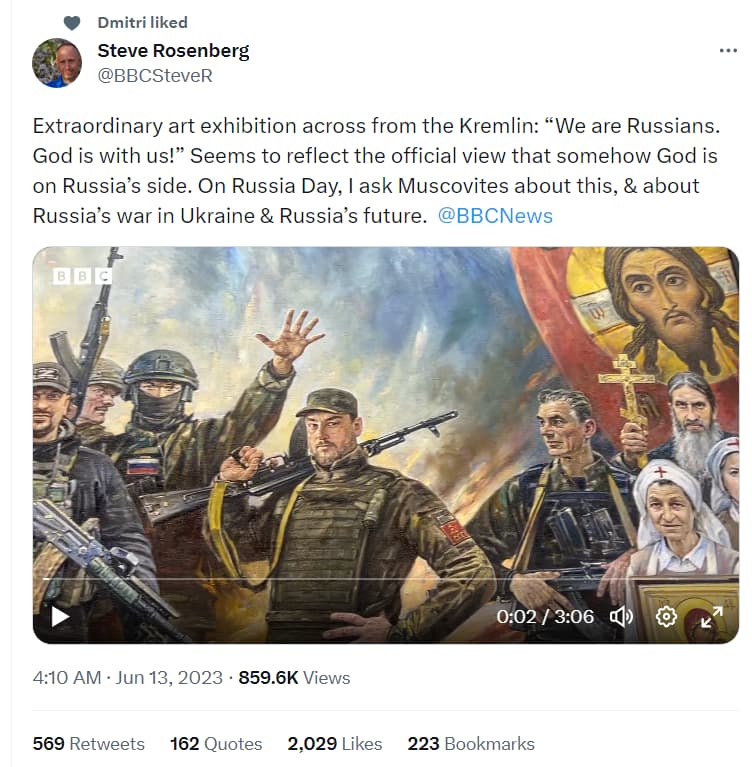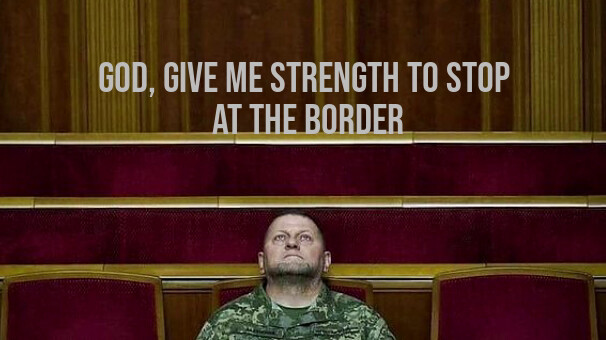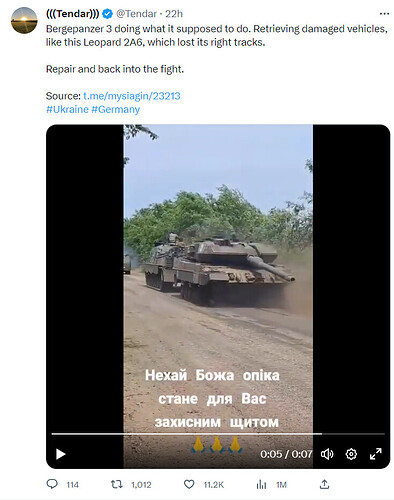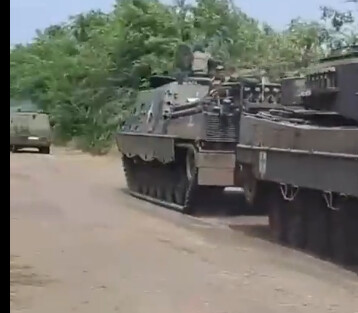The time differences can be confusing, especially when adding in the delay of info from battlefields, but there are reports on twitter of the primorsk missile strike on a “Chechen headquarters” dated June 13, and these reports mention the attack “took place last night”. So possibly several days ago (Australian time).
It’s unclear if this is the same incident as the 20th Army shelling mentioned above, or separate, or if segments of both stories have been melded and/or twisted in the confusion of war / propaganda.
Some Ukr reports suggest that Russia has cleaned up and hidden the disaster by quickly removing the bodies, but again it’s unclear which incident is which.
And regards Delimkhanov, the Russian State Duma has already modded it’s official media release several times, Ukr sources vary between he’s dead and badly wounded , and goodness knows what game Kadyrov and co are playing with their bizarre proclamations. Russian supporters now trying to claim that he was mocking Ukrainian claims of Delim death.
The more things change…
The Crimean War was notable for the catastrophic impact of cholera and other biological threats on the participants. Be a shame if the Russian forces are struck down by similar in this one.
So the current recognised borders of Russia then?
can you have negative potential?
crimea waits patiently
Ok, so this seems to suggest that the elimination of the Chechens via storm shadows was a different , and earlier, strike to the destruction of the 20th battalion in Kreminna. Rumours of a high value Kadyrov target been swirling since at least the 12th June , Ukraine time.
https://twitter.com/bayraktar_1love/status/1668909811134545922
Is Crimea recognised as a part of Russia?
I’m unsure what to make of it.
Nailing down current level of commitment as long term would be helpful, even without it being a treaty commitment.
But:
- It is being offered instead of the stronger demand from Ukraine, supported by several NATO members for a NATO Membership Action Plan (MAP)
A MAP is NOT just a “road map for Ukraine’s NATO accession”. It is:
a NATO programme of advice, assistance and practical support tailored to the individual needs of countries wishing to join the Alliance.
- The argument against providing a MAP breathlessly echoed by unpaywalled FT from anonymous briefers is utterly pathetic and increases the danger of nuclear war:
But western officials are wary of dangling the prospect of Nato membership before a country that is still at war. Alliance members cannot at this stage pledge to go to war on Ukraine’s behalf with a nuclear power like Russia, should it be attacked again, officials said.
“We don’t take in countries with an open border dispute, and ones that are, in the case of Ukraine, in a full-scale war,” said one. “It’s the wrong time to talk about Nato membership [for Ukraine].”
Officials say that the discussion about Nato membership for Ukraine obscures the more pressing need for bolstering Kyiv’s defences against Russia.
These “Western officials” need to be got out of the way. NATO was not “wary” about dangling the prospect of membership before Ukraine before this war started in 2014 and that dangling was used as an excuse for invasion. Now they are actively encouraging nuclear threats as a strategy for Russia to pursue by indicating that they will be successful.
- The argument is also a flat out deliberate lie. A MAP is explicitly NOT a pledge of full Article 5 membership but merely a logical step already taken by other non-members, in fact even by a state still under international supervision that was established by a NATO bombing campaign divided into two regions, one of which is still contested
Participation in the MAP does not prejudge any decision by the Alliance on future membership. Bosnia and Herzegovina is currently participating.
Upon decision of the North Atlantic Council, countries participate in the MAP by submitting individual annual national programmes on their preparations for possible future membership. These cover political, economic, defence, resource, security and legal aspects.
The MAP process provides a focused and candid feedback mechanism on aspirant countries’ progress on their programmes. This includes both political and technical advice, as well as annual meetings between all NATO members and individual aspirants at the level of the North Atlantic Council to assess progress, on the basis of an annual progress report. A key element is the defence planning approach for aspirants, which includes elaboration and review of agreed planning targets.
Throughout the year, meetings and workshops with NATO civilian and military experts in various fields allow for discussion of the entire spectrum of issues relevant to membership.
…
Currently, Bosnia and Herzegovina is participating in the MAP, having been invited to do so in 2010. At the time, Allied foreign ministers called on the authorities in Bosnia and Herzegovina to resolve a key issue concerning the registration of immovable defence property to the state. At their meeting in December 2018, foreign ministers decided that NATO is ready to accept the submission of Bosnia and Herzegovina’s first Annual National Programme under the MAP. The registration of immovable defence property to the state remains essential.
depends what side of the 500m table you’re on I guess
We’re gonna FUUG you up!
Just to further nonsense-ify the whole thing, Alaudinov is the same bloke who has also declared that Delimkhanov is back in Chechnya with light wounds.
Maybe there are bits of him all over the place?
By Russia and a few other countries. In short, no.
Ukraine’s Counteroffensive Begins: Shall the Leopards Break Free?
Dr Jack Watling
14 June 2023 4 Minute Read
[image]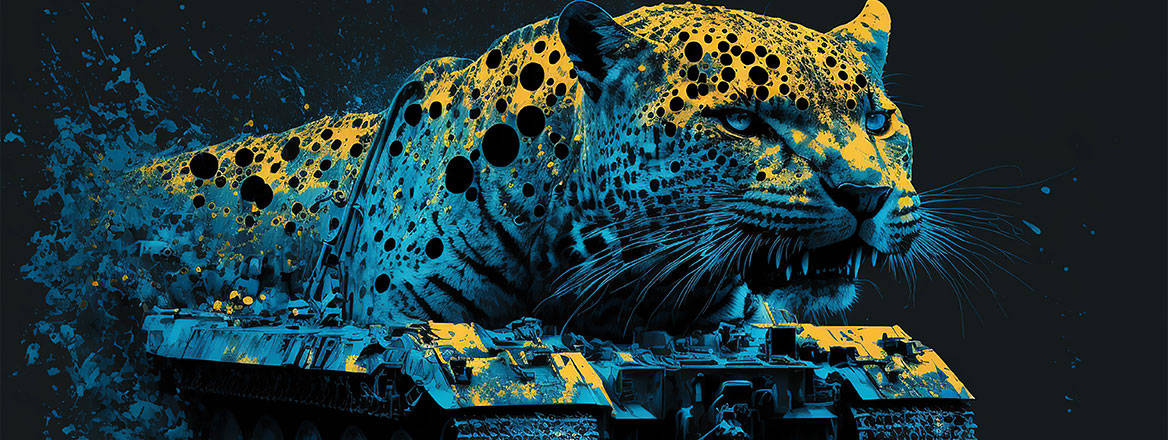
Main Image Credit Teeth bared: Ukrainian forces are attacking along a broad front to try to set the conditions for a breakthrough. Image: SmartArt / Adobe Stock
Ukrainian forces are making gains, but the offensive is some way from its decisive phase; we must refrain from premature pronouncements of success or failure.
Ukrainian forces have launched their long-anticipated offensive in an attempt to break through Russian defence lines to liberate the occupied territories. Ukrainian troops have broken through initial fighting positions along a broad part of the front, but remain some distance from Russia’s main defence line. Kyiv has yet to commit the bulk of its forces as its lead elements try to set the conditions for a breakthrough.
The fighting so far has been tough. Russia’s initial fighting positions constituted fox holes and hand-dug trenches, but behind these were complex minefields of anti-tank and antipersonnel mines, covered by Russian UAVs and artillery. The main defence line, still 15–20 km from Ukrainian positions, has properly dug trenches and concrete-reinforced firing posts, tank obstacles, ground-laid cable to coordinate artillery strikes, and even more mines. Behind that are the reserve fighting positions of the third defence line.
The fighting will likely get tougher. As Ukrainian forces penetrate deeper into the defences, they will come into range of more Russian artillery firing posts. Moreover, their own artillery will be able to deliver fewer counterbattery missions, and the Ukrainian lines of advance will become more predictable, as they must follow the breaches identified in the minefields. As Ukrainian troops push forwards, they will also be covered by fewer air defences, and will likely come under greater attack by the Russian Aerospace Forces and aviation.
Given these threats, the Ukrainian military is currently trying to achieve three things. Firstly, there is an intense counterbattery duel being fought, with both sides trying to strike each other’s logistics, command and control, reconnaissance, and artillery systems. The Russians are hunting for Ukraine’s artillery with Lancet UAVs. The Ukrainians are utilising Storm Shadow and GMLRS to try to destroy Russian command and control and munitions stockpiles.
Secondly, the Ukrainians are trying to get the Russians to commit their reserves, moving troops from the third defence line to bolster sectors under pressure. Once these troops are pulled forwards, it will become easier to identify the weak points in the Russian lines, where a breakthrough will not be met by a new screen of repositioned forces.
Success is binary, not linear. The line is either broken or it is not, and Kyiv must shape the battlefield to maximise the probability of a breach
Thirdly, the Ukrainian military is trying to put pressure across the front to advance through the first line of defences in as much breadth as possible. The reason for this is to increase the options for attacking the main defence line and to keep Russian forces uncertain as to where the main effort will be launched. Furthermore, with such a long front, stretching out Russian troops limits their ability to stack units in depth, pulling more forward.
At some point, the Ukrainians will have to decide where to commit their main assault units, and the offensive will enter its decisive phase. This decision must be conditions-based. It isn’t about adhering to some fixed timeline. When these units are committed, the offensive will either achieve a breakthrough or fail. Success is binary, not linear. The line is either broken or it is not, and Kyiv must shape the battlefield to maximise the probability of a breach.
The extent of a success will be determined by how much progress is made on the other side of the breach. If a breach can be achieved, then the critical question will be how many units Ukraine has in reserve to surge forward and exploit the success. If operations are currently methodical, once a breach in the line occurs, speed will be of the essence.
The uncertain variable in the current offensive is Russian morale. Russian units are currently fighting from prepared positions and their command-and-control infrastructure is mostly intact, though some key command posts have been struck. If Russian units can be forced to reposition, however, the poor training and discipline of Moscow’s forces could see the defence become uncoordinated and susceptible to collapse. Bringing about such conditions would require some significant actions by the Ukrainians to get the Russians moving, but it is possible under such conditions for the strength of the defence to crumble rapidly. Ukraine can endeavour to bring such a situation about, but it cannot be counted on.
For Ukraine’s international partners, the summer is likely to be deeply uncomfortable. Losses will mount and success will take time. It is vital, however, that there is no diminution in the strengthening of the training programmes allowing Ukraine to continue to generate combat units, or the mobilisation of defence industry to put supply to the Ukrainian military on a sustainable basis. However much territory is liberated in this offensive, the critical variable is convincing the Kremlin that even if its defeat comes in stages, it is coming.
Although the Port of Sevastopol IS recognized as part of Russia
Forgot to add:
- This is coming at the same time as some of this “Quad” are again muttering about the current offensive setting conditions for a more favourable negotiated settlement with articles supporting Kissinger’s updated position from previously opposing NATO membership for Ukraine to now hoping it can be used to restrain Ukraine.
There could be a real danger of prolonging the Russian regime and laying the foundations for a “frozen conflict” by refusing to provide what Ukraine needs to complete recovery of Crimea.
Great article
